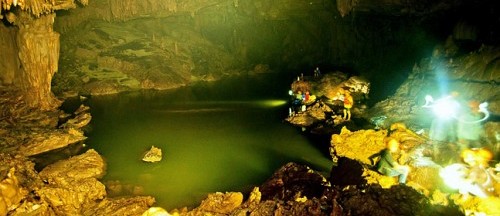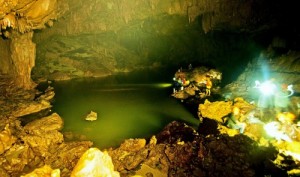39 new caves have been discovered at the Phong Nha-Ke Bang National Park in the central province of Quang Binh. The discovery was made by explorers of the British Royal Cave Association and the Hanoi College of Natural Sciences during a joint survey conducted by the two groups from March 16 to April 25. The newly-found caves have a total length of 17 kilometers and now raise the total number of caves in the UNESCO-recognized site to 300.
The new cave system is considered heterogenous as there are different formations such as dry caves found in the high terrain while there are also geologic sinkholes or doline caves similar to that of Son Doong Cave, the latter of which holds the title of the current biggest cave in the world. Three of the newly-discovered caves were found to be of the highest significance in terms of geomorphologic and geological factors. May (Cloud/s) is 1,100 meters long and 200 meters deep; Vuc Moi (New Abyss/ Chasm) is 213 meters deep; while Lan (Orchid/s) is 1,230 meters long.
But many other of the recently-found grottos are also considered scientifically important: A Ky Cave which is located at Trail 20, on the East part of the area. It is 1,260 meters long and has a hydrologic system (spring/ stream) inside sourcing from Laos; Vong Phu Cave is formed on the high stratum of the limestone mountain at 840 meters long and 146 meters deep. It is situated at the opposite side, on the West, and takes about three days of trekking from Coc Coc Village before it can be reached; Khe San and Vuc The Cave are found at 24 kilometers to the West of Trail 20. The latter cave is a new discovery in the grotto classification in the park.
The rest of the new cave systems are just as significant to the scientific world. Thach Sinh and Khe Dung Caves have sinking holes which are the same as in Son Doong. But unlike the latter, these ones even have an entrance below the holes. Khe Dung Cave, found on the North of En (Swallow) Cave, is uniquely situated in a place where there are very few little limestone mountains. Bang Cave has a small entrance, but has the capacity to store huge amounts of water in the rainy season. It is 662 meters long.
Phong Nha-Ke Bang National Park is known for its cave and grotto systems. It was founded in the first place in order to preserve one of the world’s two biggest karst regions composed of 300 caves and grottoes totalling to 70 kilometers in length. As a result, it holds a number of world cave records such as the longest underground river and biggest caverns and passageways in the world. It was hailed as a World Heritage Site in 2003 by UNESCO for its tremendous geological value and rich biodiversity.
The park also preserves the Annamite Region’s limestone forest ecosystem located at the North-central coast of Vietnam. Phong Nha-Ke Bang is situated in a 2,000 kilometer square limestone zone about 500 meters South of Hanoi, in Vietnamese territory. But it is also located on the border of another limestone zone called Him Namno which is of equal size and situated in Laotian territory. Le Thanh Tinh is the director of Phong Nha-Ke Bang National Park.
Aside from the discovery of the new grottoes and caves, the field trip also recorded measurements and produced pictures which were forwarded and posted at the park’s grotto map. Phong Nha-Ke Bang National Park is hailed as the most important grotto system globally. This was the 16th survey done within a 24-year period. The total length of discovered caves in the area now covers 200 kilometers.

